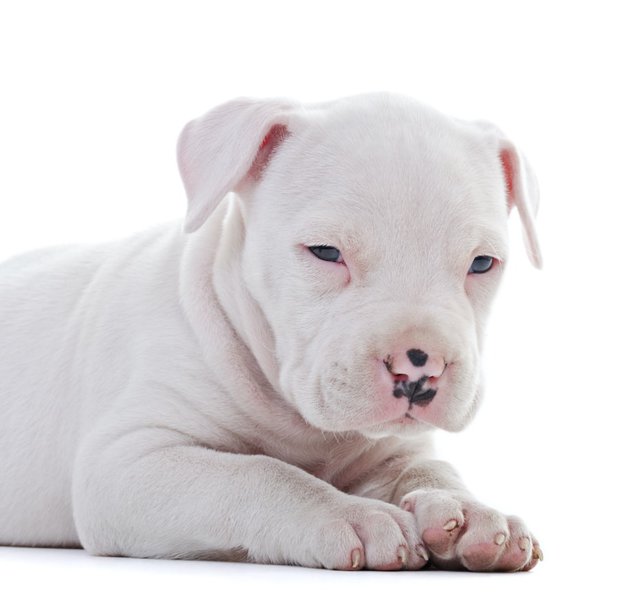Pitbull (Pit Bull) is a blanket term used to describe bull breed types of dogs. To the surprise of many people, it is not a purebred dog breed. And because of that, Pitbull dogs are adorned in a large variety of beautiful coats, colors, and patterns.
The most common coat colors of the Pitbull include black and red, combined with white, blue, or black mask and a bonus coat pattern, with the merle pattern being the rarest.
While there are plenty of dog types placed under the Pitbull umbrella, only four are considered true Pitbull dog breeds: American Staffordshire Terrier, Staffordshire Bull Terrier, American Bully, and American Pitbull Terrier.
In this article, we’ll describe for you 36 of the most beautiful colors and patterns of the Pitbull, beginning with the rare masks and body markings to the ordinary white color.
36. Black Mask
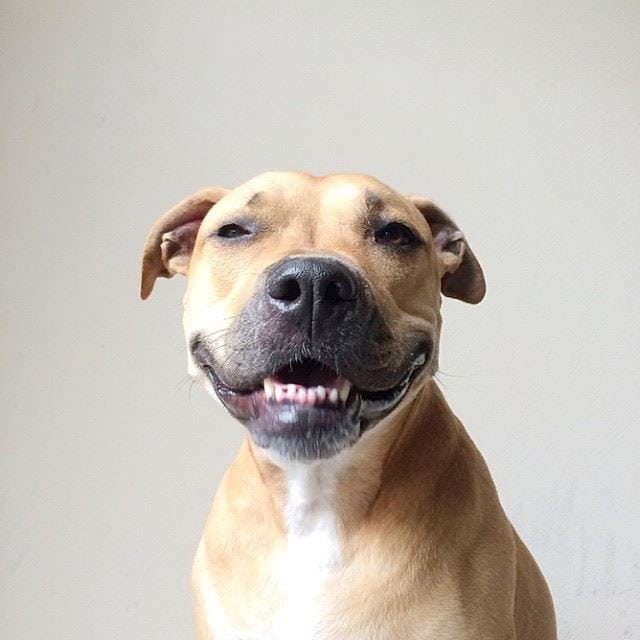
The black mask around a Pitbull’s nose, also described as a Melanistic face mask, is indicative of the black mask allele (Em) in the E (Extension) locus. The black mask is expressed on dogs that don’t have a solid black coat even though the dog may carry the black mask allele.
A pair of the black mask allele or any combination with the other 2 E locus alleles (E, and e) results in a Pitbull with a black mask. This means that the black mask allele is dominant to all the other alleles of the E locus.
35. Blue Mask
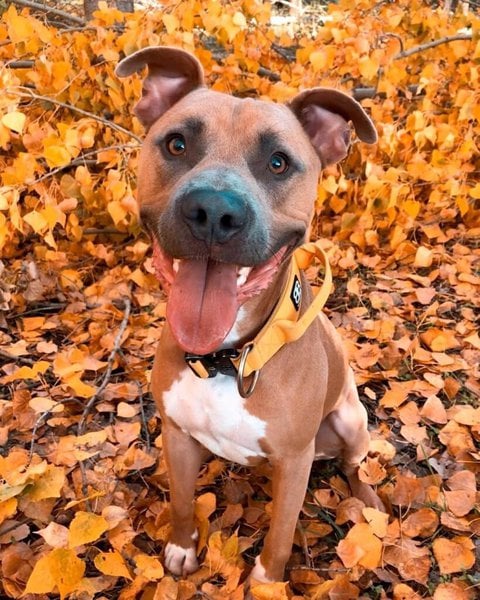
The blue mask, like the black mask, is caused by the Em black mask allele in the E locus. The Extension Locus affects the distribution of the Eumelanin pigment.
The expression of a blue mask depends on the color of the Pitbull. For example, a blue fawn Pit with a majority fawn color and a blue tint will show the blue mask if it has the allele, considering its lighter fawn background. Instead, a solid blue Pit with a dark blue muzzle may not allow the blue mask to be visible.
34. White Mask
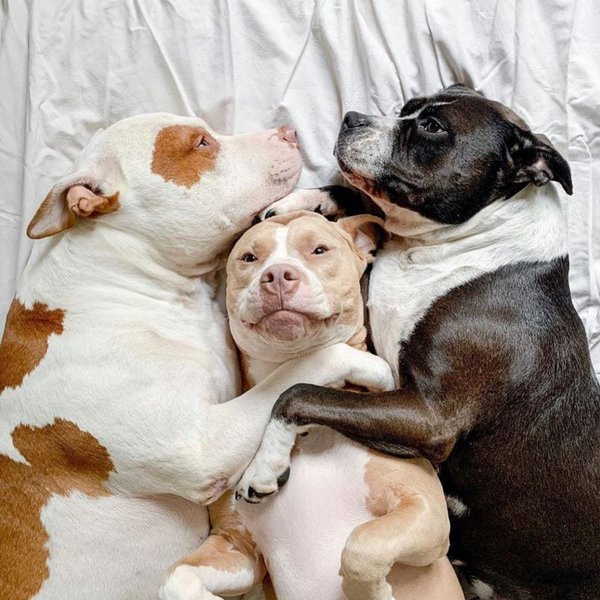
A white mask on a Pitbull has to be on a dark background to be visible. Even though they have the black mask gene (Em), the black color is overridden by the white spotting gene (S locus) and specifically the extreme spotting allele (Sw) that indicates the absence of pigmentation on the area around the nose.
The white mask on a Pitbull may sometimes extend to one eye while the other eye maintains the background color.
33. Full Body

Full body Pitbulls have a solid color throughout the body. This is solely determined by Pitbull’s gene pool. Genes determine what color pigments are produced in a dog (Eumelanin or Pheomelanin) and where the pigments will be represented on the coat.
In solid coat dogs, genes direct the same color pigment to be produced on the entire body. Solid-color coats in Pitbulls include black, blue, red, brown, fawn, and tan. But full-body Pitbulls without even a little white are rare.
32. White Markings Or Piebald
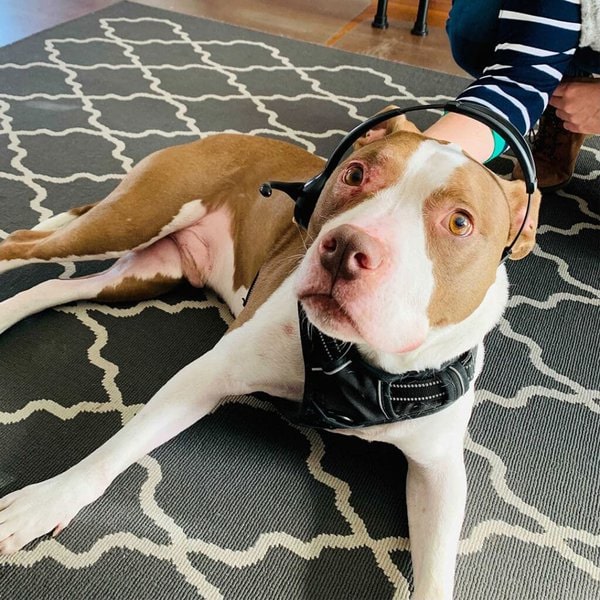
If your Pitbull dog looks like a Holstein cow, then it is piebald. The Piebald dog coat has unpigmented white markings alternating with pigmented sections. The color distribution may be between 20 and 60 percent.
As with the spotted Pitbull, Piebald Pits have white markings thanks to the MITF gene or the S locus. The Sp allele in the S locus is a recessive allele that controls the piebald pattern and the amount of white depends on the number of allele variants that the Pitbull carries.
31. Brindle Pitbull
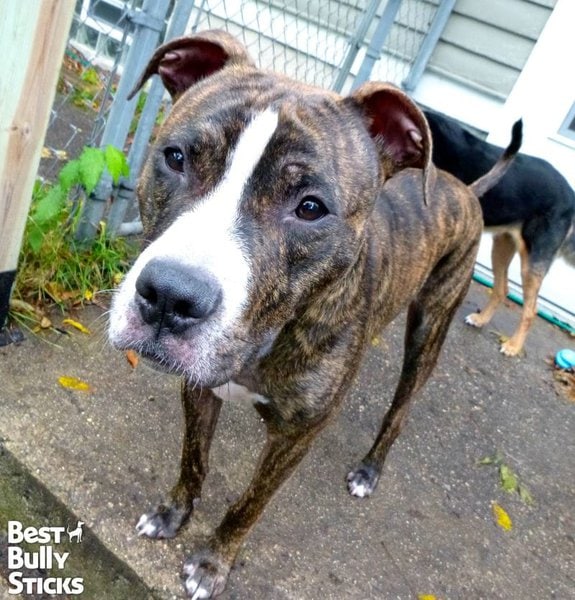
Brindle is a rare pattern in dogs including Pitbulls. Genetically, this can be explained by the fact that the KBR allele in the K locus that is responsible for the brindle pattern is recessive. In other words, the Dominant Black (K) usually subdues the brindle allele.
A brindle Pitbull receives a pair of the brindle allele from the parents. But the brindle allele (KBR) dominates the non-black (KY) allele in the K locus and will also produce a brindle dog when the two alleles are paired (KBRKY).
30. Sable Pitbull
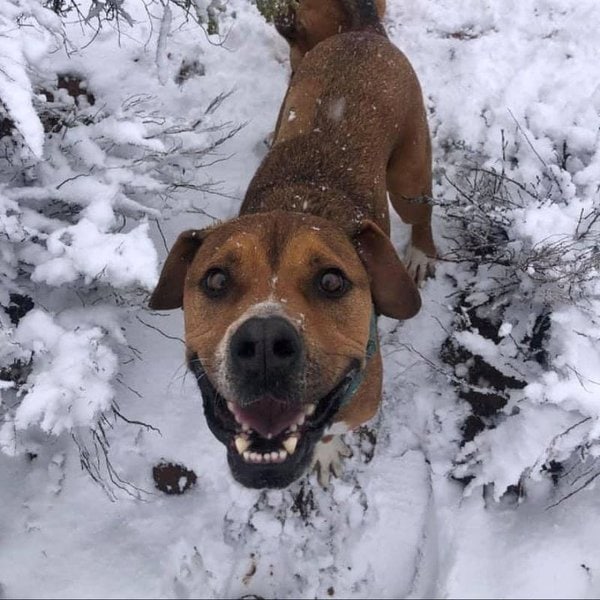
Sable Pitbull dogs have a black overlay over a basic coat color. The basic color could be fawn or red. The black overlay is on the hair tips and can be heavier or lighter depending on gene action.
Sable color is caused by the recessive sable allele (ay) which is one among the four alleles of the ASIP gene or Agouti (A) locus. Some sable dogs will have a black mask extending from the nose to the face.
29. Spotted Pitbull
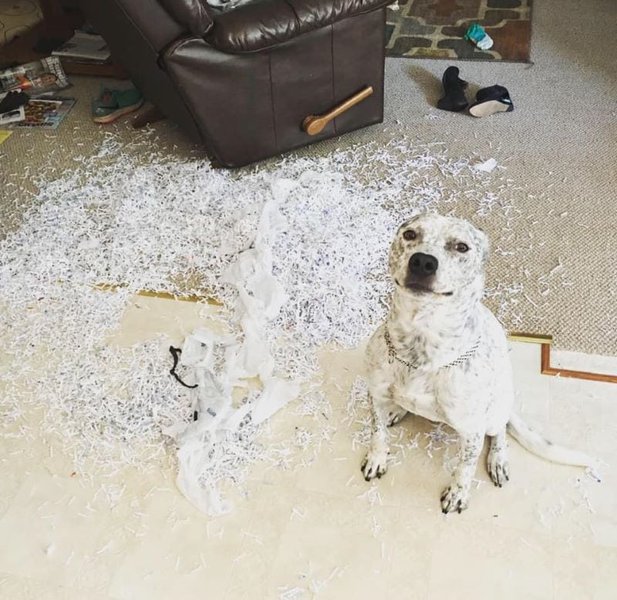
Spotted Pitbull dogs have irregular white spots on the body. Studies have concluded that the Microphthalmia Associated Transcription Factor (MITF) or S locus is responsible for the irregular white spots and patches on a dog’s body.
This gene controls the melanocytes, the cells responsible for making pigmentation, and the white coat comes as a result of absent melanocytes.
Spotted Pits are rare and may readily be confused with the merle Pits. But Merle Pits have smaller and larger irregular spots and patches alternating on different parts of the coat.
28. Merle Pitbull
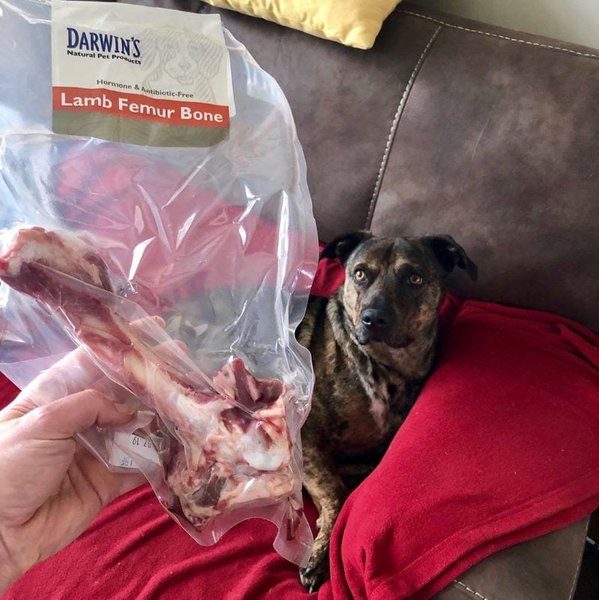
Merle dog coats result from the merle dominant allele in the M locus. This allele dilutes solid black parts of the coat into broken patches/sports of a lighter color (gray or white) and can have variations depending on whether a dog is heterozygous (Mm) or homozygous (MM) for the merle.
Different from the spotted Pit, merle spots on a Pitbull coat is irregular with some presenting in larger sizes. Merle Pits have blue eyes, and as we tell you in the FAQs section, they are the rarest.
27. Tan Points
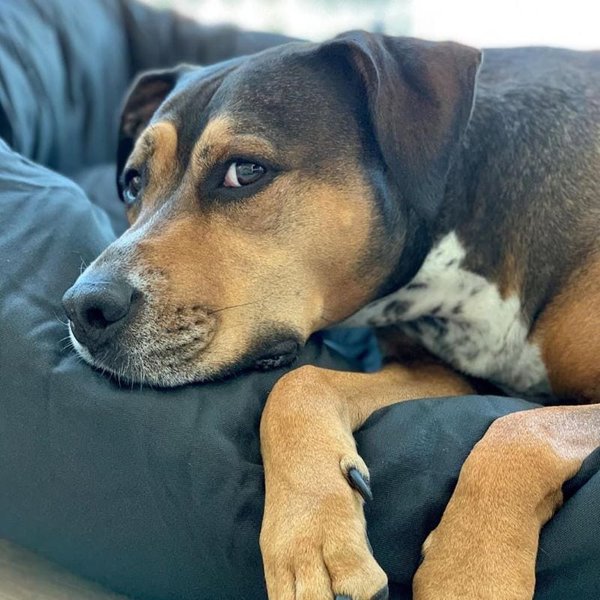
Tan points in Pitbull coats are mostly found on dogs with solid black and diluted-black coats like blue and brown as well as the tricolored Pits where white is the third color.
Generally, tan points are present on the Pitbull’s legs and paws, above each eye, on the cheeks, on the muzzle, on the underside of the ears, and the neck, and chest. The tan points can vary in color intensity from a light cream to a darker red.
26. Patched Pitbull
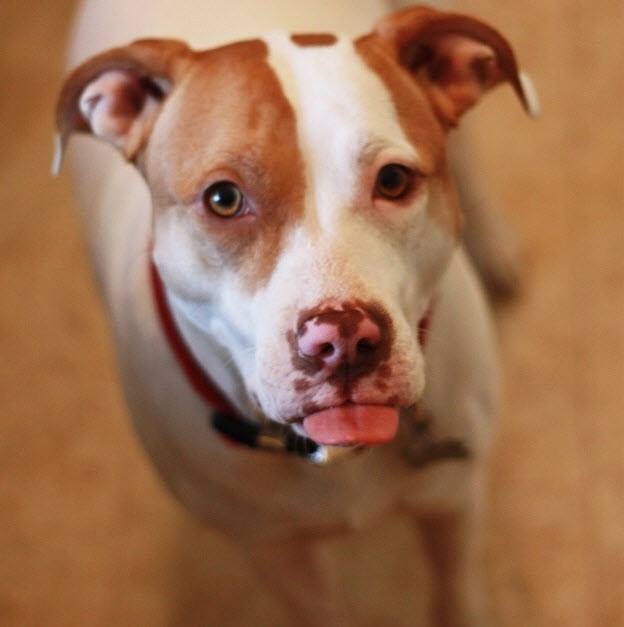
Patched Pitbulls have large patches of a darker color on a majority white base coat, different from the white markings where white is on a majority darker base color. They also have a patch area around the eye.
Dark spots or patches on a dog coat are controlled by the Harlequin phenotype (H locus). The H allele in the H locus controls the point mutation while the h allele is a wild type controlling other dark markings of the white coat such as the patches.
25. Brindle Points
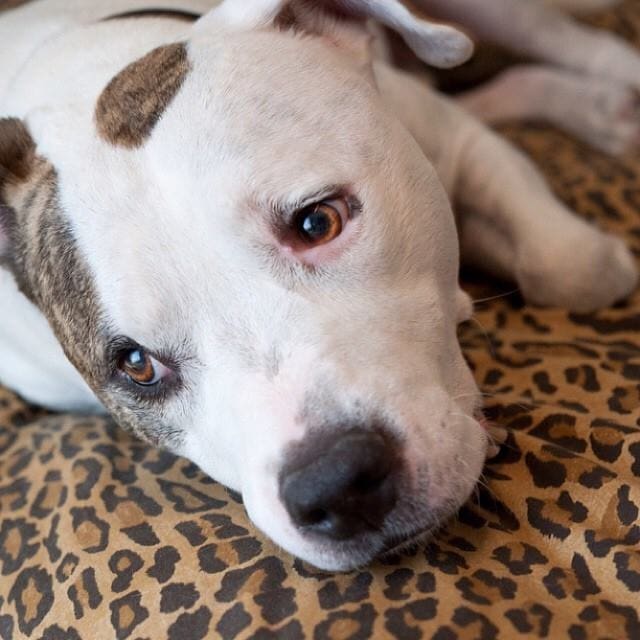
A Pitbull coat with brindle points has brindle combined with patched areas on the coat. Since the brindle gene KBR allows the expression of the A locus, a Pitbull’s coat can show brindle patterns in dark patches of the coat.
A Pitbull with one or two brindle alleles (KBR) will express the genes it has at the A (Agouti) locus, which also means that the extent of the brindle points on the coat depends on the A locus.
24. Tricolor Pitbull
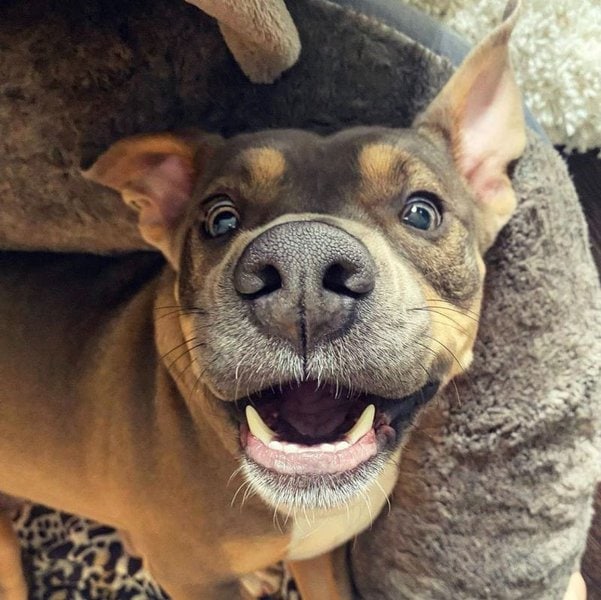
Tricolor Pitbulls come in a combination of three coat colors, making them look quite elegant. The most common tricolor combination is black, white, and tan as in the case of the featured Pitbull dog. But tricolor Pits could also be blue, white, and tan among other combinations.
Tricolor Pits are popular among Pitbull lovers but rare because breeders did not focus on breeding them in the past.
Genetically, tricolor Pits are caused by a recessive allele (at) in the Agouti (A) locus whose combination (at/a or at/at) could also yield a tan or black phenotype.
23. Black Pitbull
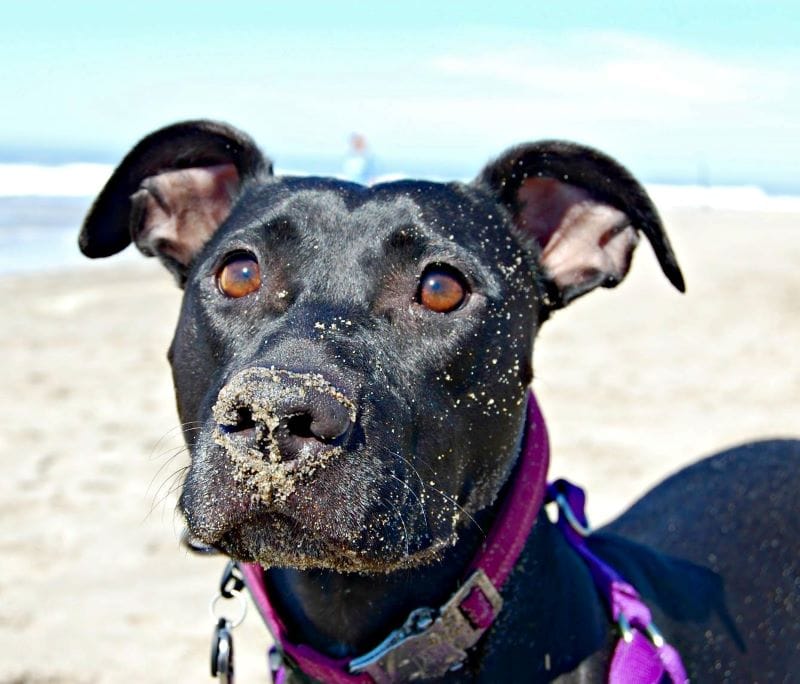
There are two basic dog coat color pigments: Eumelanin and Pheomelanin. Black is the basic eumelanin color in dogs while red is the basic pheomelanin color. The black color is common in Pitbulls.
When a Pitbull is solid black (with or without a small patch of white), they are Dominant for the black color on the coat and the eyes, even though the eyes could be brown.
There’s a recessive black gene that gives black Pitbulls an all-black coat. But this resulted from a mutation a long time ago and is only possible in a few breeds.
22. Black & White Pitbull
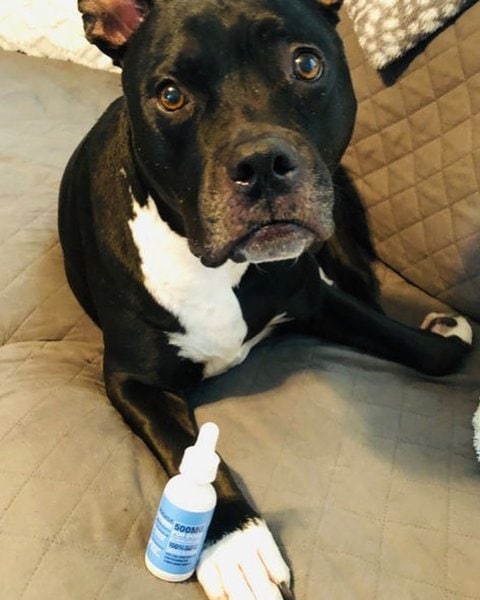
Black & white dogs have coat patterns that may vary from a simple stripe on the chest to the more complex particolored and piebald patterns.
Whether they are Pitbulls or another breed, these dogs have the Eumelanin pigment expressed in the parts of the coat that are black. The absence of pigment cells is responsible for the white patches.
Black and white Pits are often seen in a bad light because of their past as fighting dogs. But that does not mean they cannot make good family pets.
21. Black & Tan Pitbull
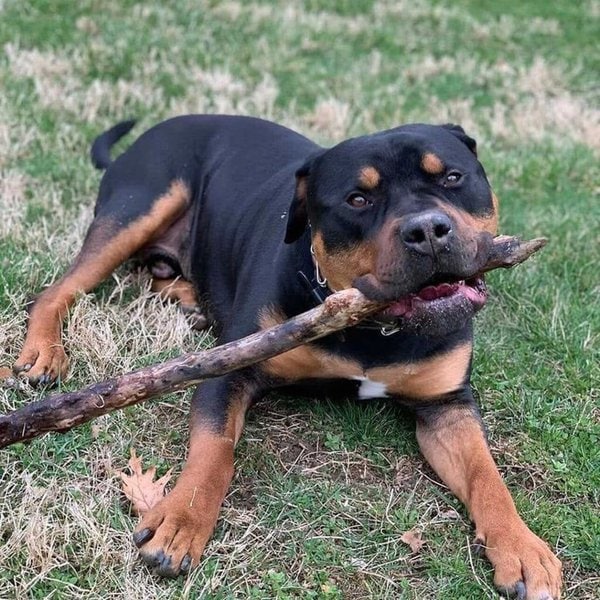
A Pitbull that’s black with tan points or markings is striking but rare. This is because tan markings are only active for dogs that are homozygous for the KYgenes.
The presentation of tan markings on black is determined by the agouti (A) locus as long as the dog has the KYKY genotype. Any dog with a dominant black gene will not be able to show tan markings because the Dominant black dominates the A locus and cannot be modified by the tan color allele.
20. Black Brindle Pitbull
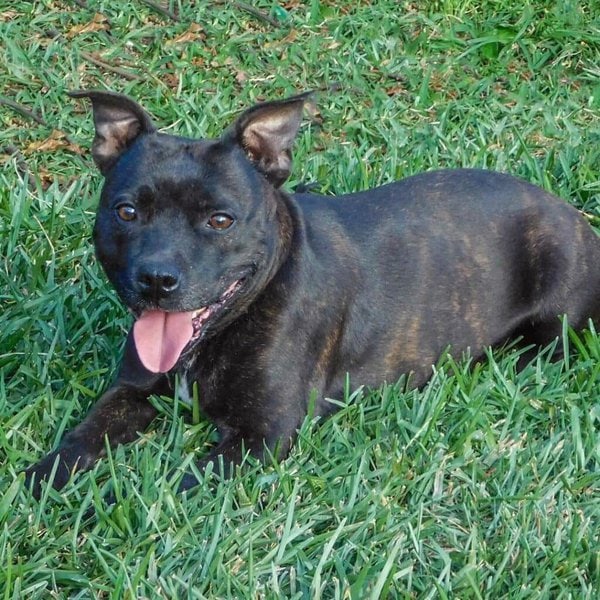
A brindle black Pitbull coat is the hardest to notice among other brindle variants. The tan-colored ‘tiger stripes’ that come over a basic black coat are kind of darkened by the overall black. Nonetheless, any brindle Pitbull looks adorable to most Pitbull lovers.
To be black brindle, a Pitbull will have to carry the KBR (brindle) allele, which is one of the recessive alleles in the K locus and adds brindle on any red markings.
19. Blue Pitbull
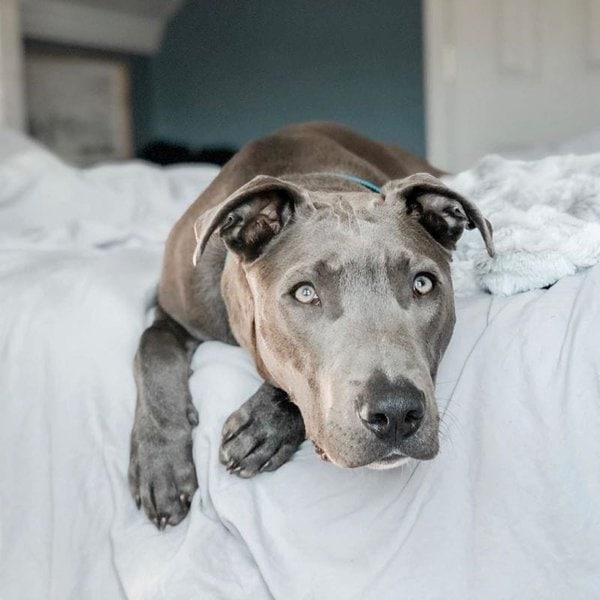
Pitbull puppies are generally in high demand. But according to the American Pit Bull Registry, blue Pitbulls are overall the favorite among prospective owners and are in high demand, even though blue is one of the rarest Pit coat colors.
Genetically, blue is a dilution of black and can range from a deep to a lighter blue. Blue Pits have blue noses, and even if those with a deeper blue may seem like they have a black nose, that is not the case.
18. Blue & White Pitbull
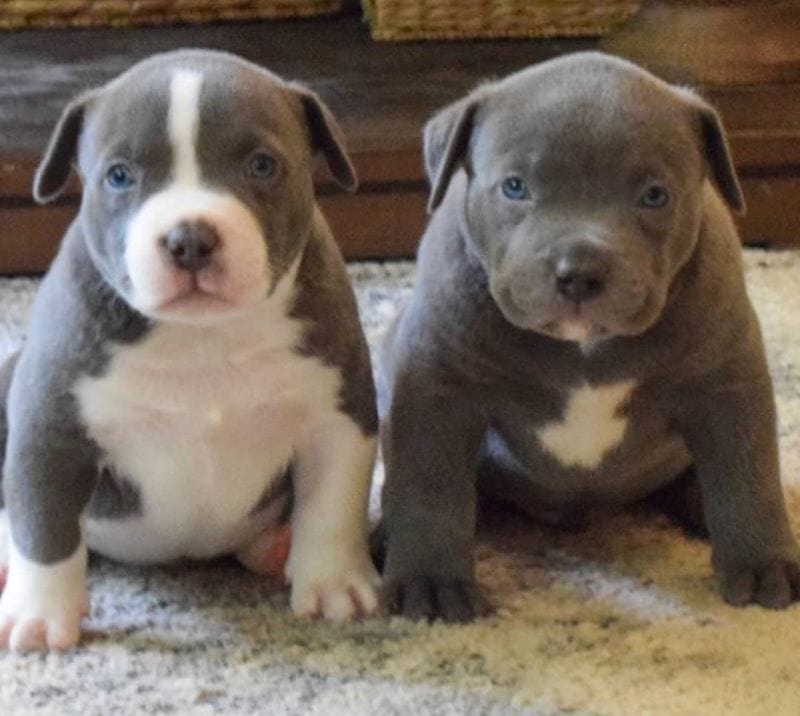
Blue & white Pitbulls have blue color on their body and a patch of white color on the neck down to the chest and sometimes on the feet. White marks may also appear on the forehead and muzzle.
While the blue part of the coat happens because of the action of the dilution gene to the basic black, the white marks are on the parts of the coat where pigmentation cells are completely lacking.
17. Blue Brindle Pitbull
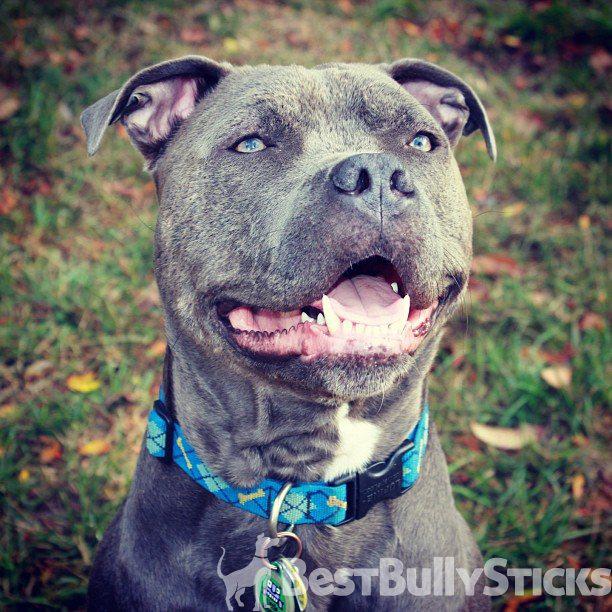
Blue Brindle Pitbull dogs have a blue basic color that could vary in intensity and gold/cream stripes. Depending on the intensity of the blue background and how light the stripes are, the brindle in blue may be easily or less easily noticed.
As with the blue Pitbulls, blue brindle Pits have a blue/gray nose and never a black one. They may or may not have white patches on their body, especially around the neck and down to the chest, on the face, muzzle, and paws.
16. Blue Fawn Pitbull
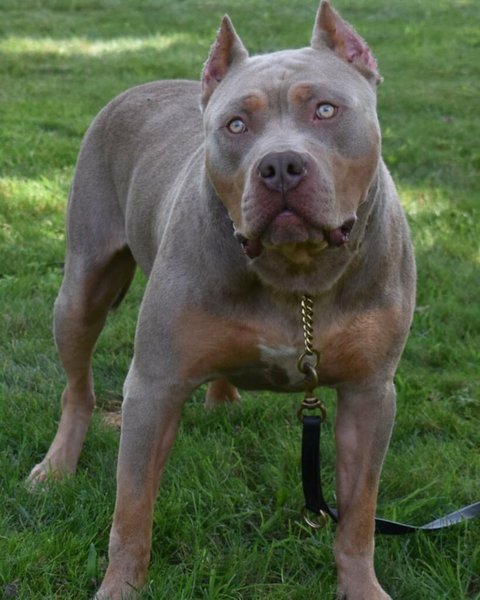
Blue fawns are among the rare but fascinating variations of the blue Pitbull. They have a silvery blue basic coat color with spots and overlays of the fawn. Note that you may find a dog with a basic fawn coat and blue tints also described as a blue fawn dog.
The nose of a blue fawn may be quite dark as to appear black, but it’s blue as with all the other blue variants.
15. Blue Fawn Brindle Pitbull
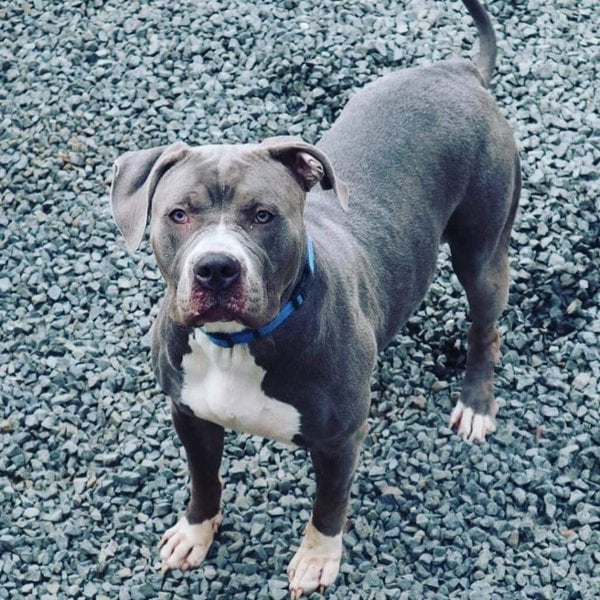
The Blue Fawn Brindle Pitbull has a complex combination of colors. Essentially, it will have a basic blue color with fawn tiger stripes that make the brindle pattern.
As with the blue fawn, you will find variations in dog coats described as blue fawn brindle with some dogs presenting a combination of dark stripes on a blue fawn color and others having a fawn background with a tinge of blue and dark stripes.
14. Fawn Pitbull
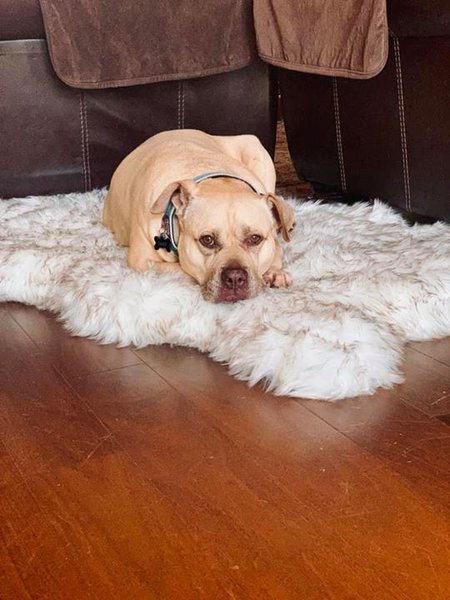
Fawn is one of the more common coat colors among dogs. The fawn in Pitbulls can vary between a brown-red-yellow with a temperate glow and pale brown, and no red or gold tones because the fawn belongs to the Dominant Black (K-locus).
It isn’t clear what causes the dilution that creates the fawn color. Suggestions indicate it could be either the l-locus for color intensity or the CCH (Chinchilla dilution) that is within the C-locus.
13. Fawn Brindle Pitbull
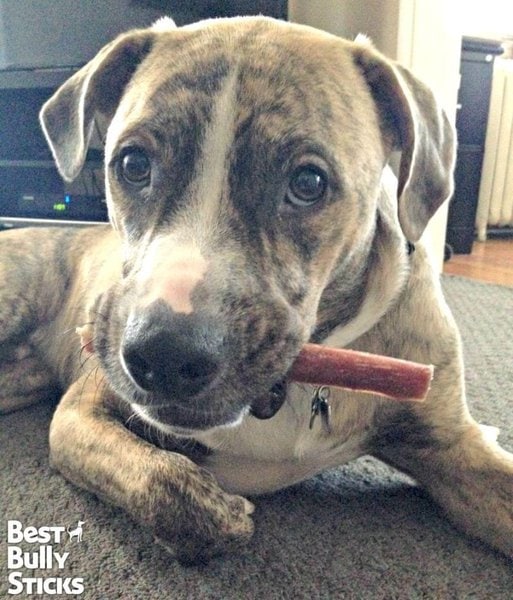
Fawn Brindle is one of the brighter brindle dog coats. You can tell a Fawn Brindle from afar because the black stripes are distributed on a brighter base color compared to darker base colors like black brindle and liver brindle that are harder to notice.
Even though they are rare, fawn brindle Pits are not as rare as the blue fawn brindle Pitbulls, but they present an equally elegant coat.
12. Fawn Sable Pitbull
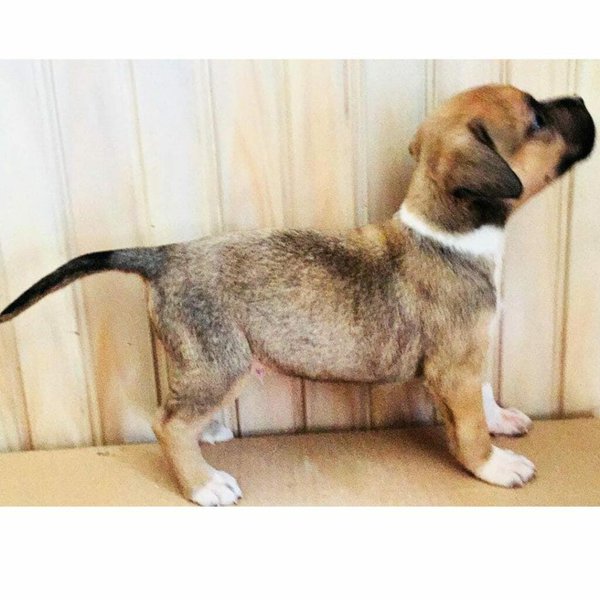
Fawn sable coats are a rare variant of the Fawn Pitbulls. Sable means dark black or somewhat dark brown. Hence, fawn sable Pitbulls have a basic red color coat with a black overlay. The overlay can be lighter or heavier depending on gene interaction.
The black overlay is also on the fawn sable Pitbull’s muzzle, sometimes creating a black mask that’s darker than the rest of the body. The eye rims are also darker and so is the tail.
11. Bronze Pitbull
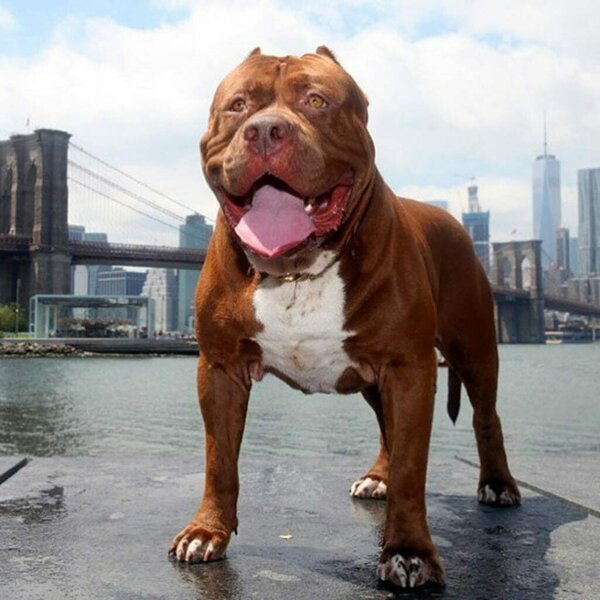
Bronze coat color is among the rare Pitbull colors and a variant of the red pigment, pheomelanin. The default colors of this pigment are yellow and gold, but the action of dog coat color genes creates reds with different intensities including Irish setter (deep red), cream, tan, yellow, orange, and bronze.
Bronze Pitbulls have a brown muzzle and eye rims. You will differentiate a bronze Pitbull by placing its color range between the red and river variants.
10. Brown Pitbull
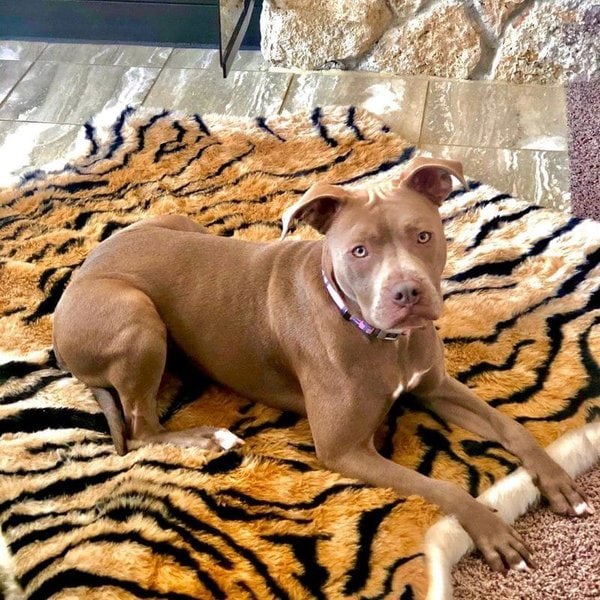
The brown coat in dogs is a dilution of the black color that is dominant in the Brown (B) locus. To have a brown coat, a Pitbull puppy must have both parents carrying the recessive ‘B’ so that they have a ‘BB’ to dilute the black pigment to brown.
Depending on the strength of dilution of the dominant brown, the coat can be brown, chocolate, or liver. The nose, eye rims, and paws of brown Pitbulls are also brown considering that the dominant ‘B’ allele is silenced by the ‘bb’ allele.
9. Brown And Tan Pitbull
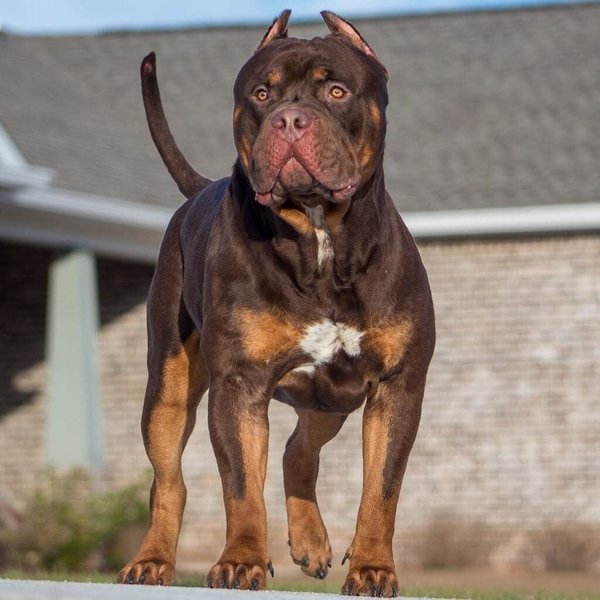
Brown and Tan Pitbull dogs have a majority brown color on the body and tan points in various points. Genetically, a Pitbull or any other dog needs to be homozygous for tan points to express them. Even though recessive black is rare, dogs that are heterozygous for tan and recessive black can express the tan points.
As seen on the Pitbull image above, true tan points are expressed above the eyes, on the cheeks, on lips and lower jaw down to the throat, on the chest, the lower side of the tail, and on the feet spreading up the inner side of all legs.
8. Brown Brindle Pitbull
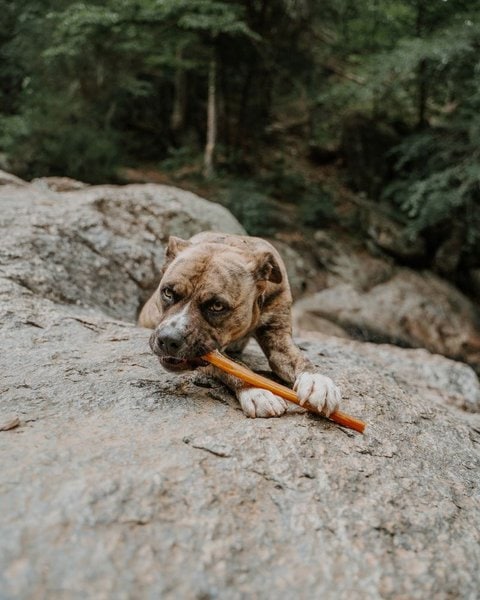
Brown brindle Pitbulls have black ‘tiger stripes’ on a brown base color, which makes the brown appear relatively lighter than it should by itself.
As with all brindle dogs, the streaks of the darker color are irregular and may appear more concentrated in some parts of the coat than others, thanks to the complex interaction of coat color genes. The muzzle and eye rims are black and a white patch may appear on the chest.
7. Liver Pitbull
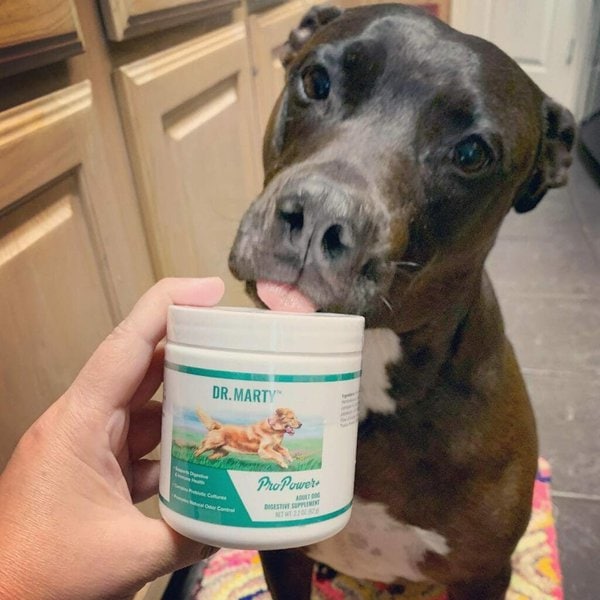
If your Pitbull dog has a dark brown coat, then you have a liver Pitbull thanks to the B-locus (Brown).
Due to color dilution by genes, the basic black pigment is turned into liver color by inhibiting the production of full-strength eumelanin. This is also the case with Isabella and blue coat colors.
Liver Pitbulls also have liver/brown noses, lips, and footpads. Their eyes are usually lighter with a yellowish shade, often described as amber or gold.
6. Liver Brindle Pitbull
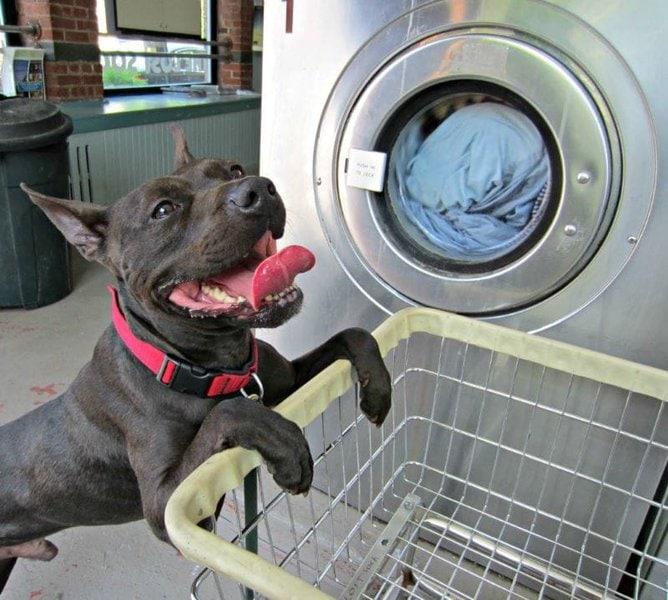
Liver and Brindle do not normally occur together on most dog breeds, but the combination is quite common among Pitbull dogs compared to others.
Liver Brindle Pitbulls have a coat with liver as the basic color and the standard brindle ‘tiger marks’ of another color.
Similar to the black brindle, liver brindle stripes are harder to notice on a Pitbull’s coat when compared to other lighter colors like the red brindle. The nose of a Liver Brindle will be liver/brown.
5. Red Pitbull

Red Pitbull dogs are among the common and most sought-after coat colors. They have a deep or lighter red depending on how gene interaction impacts the pheomelanin (red pigment).
Generally, if you have a red Pitbull, the nose and eyes will be black as eumelanin (black pigment) acts on these points irrespective of the red color intensity on the coat. But the brown allele can change the color of the nose, eyes, and foot pads to brown for dogs in the red pigment family, which is why your red pup may be one of the rare brown nose Pitbulls.
4. Red Brindle Pitbull
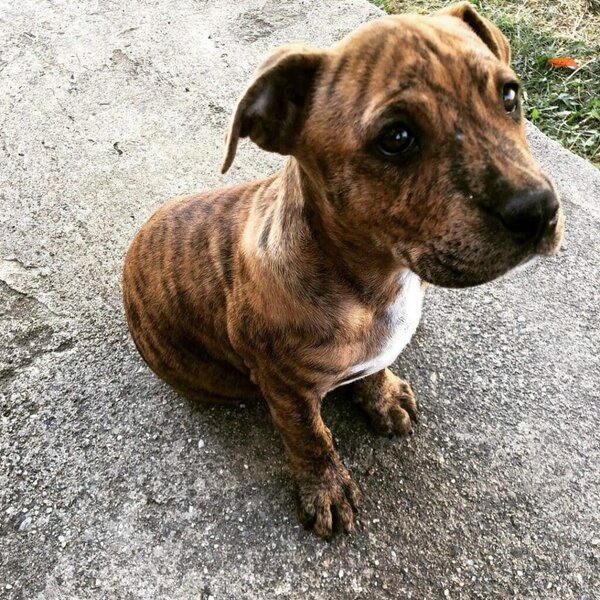
One sure thing about brindle dogs is that they are quite beautiful. These dogs have dark ‘tiger stripes’ on a basic dog color coat which are caused by one of the recessive alleles of the Dominant Black (K-locus) gene.
The prominent color in a brindle dog determines the name that is then followed by the brindle term. So, a red brindle Pitbull has red as the basic color and then dark stripes that make the brindle pattern.
3. Red Sable Pitbull
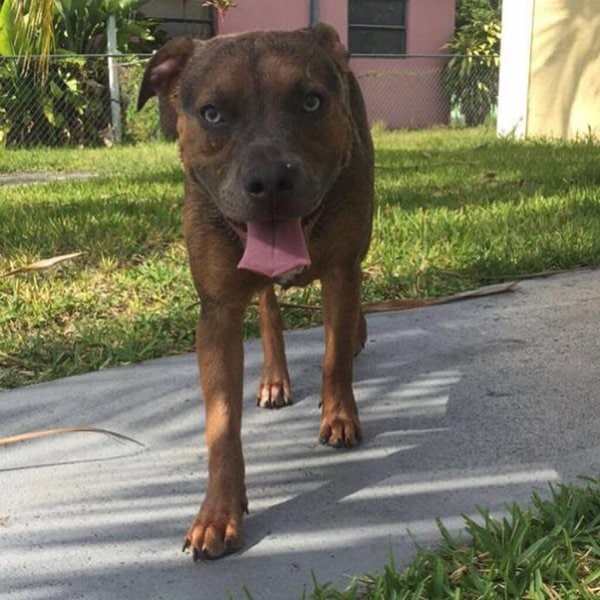
The ay genotype is responsible for the sable color in dog coats, often described as black-tipped hairs. In the absence of the K-locus allele (Dominant Black), the dog will have another base color, in our case red, hence the red sable. For example, the featured Pitbull dog has a red coat with black tips on the hairs.
Gene interaction determines how much black will be in every red hair of your Pitbull, explaining why some red sable Pitbulls appear lighter or darker than others.
2. Seal Brown Pitbull
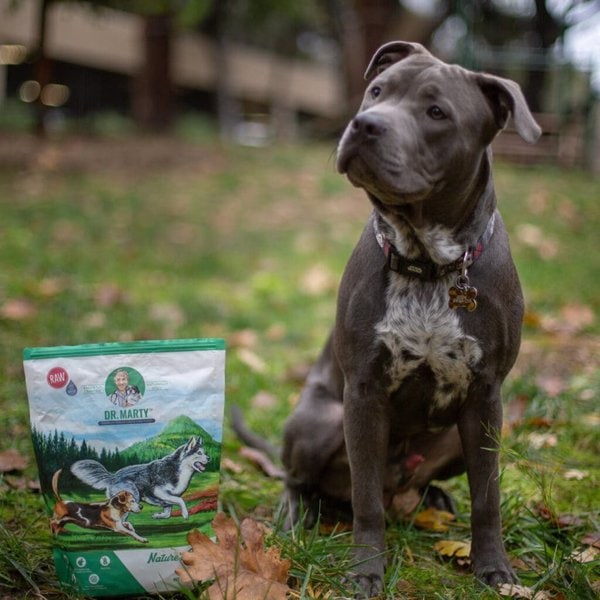
A seal brown Pitbull appears to be generally black. When viewed closely, however, the dog has shades of brown or red that appear like a glow over the black.
The genetic cause of the seal tinge is not exactly understood. So, dog color experts explain it as a black coat that has incomplete dominance.
The seal brown coat color in Pitbulls is rare and when it comes, it will readily be mistaken for the chocolate coat color.
1. White Pitbull
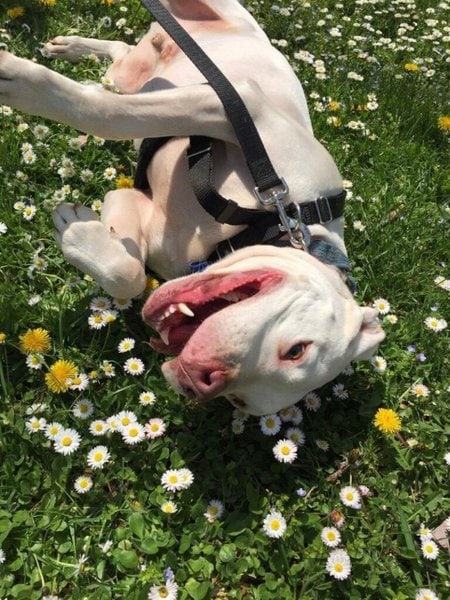
Like all other dogs, the white color in a Pitbull’s hair occurs when Melanocytes, the cells that cause pigmentation on a dog’s coat, are completely missing. This is why white dogs are described as ‘Extreme White’ denoted by the Sw allele in the S locus.
If dark pigmentation is produced in the nose, a white Pitbull will have a dark nose otherwise the Pitbull is albino, marked by a pink nose.
White Pitbull dogs are among the rare variants, and even though they are widely sought after, they are also associated with genetic-related deafness and susceptibility to cancer.
Related Questions
Are Blue Pitbulls More Aggressive? There is no reliable proof that blue Pitbulls are more aggressive. While it’s true that Pit Bulls were purposely bred for aggression and this may have aggravated their genetic dog tendency to aggression, the American Pit Bull Foundation indicates that the idea that Pitbulls are more aggressive is only a myth. Besides, studies have shown that Pitbulls don’t necessarily top the list of the most aggressive dog breeds.
What Is The Most Common Pitbull Color? The most common Pitbull colors are black and red. The black Pitbull may be solid or have a small white mark, especially the tie-like patch on the chest. The red Pit may vary in intensity between a lighter and deeper shade and may also have the white mark on the chest or the paws.
What’s The Rarest Pitbull Color? According to the American Pit Bull Registry, Merle Pitbulls are by far the rarest, which explains the sharp rise in the demand for these Pits. Pitbull owners love the unique color variations of the merle Pit and its blue crystal eyes that are caused by the merle dominant allele in the M locus.

